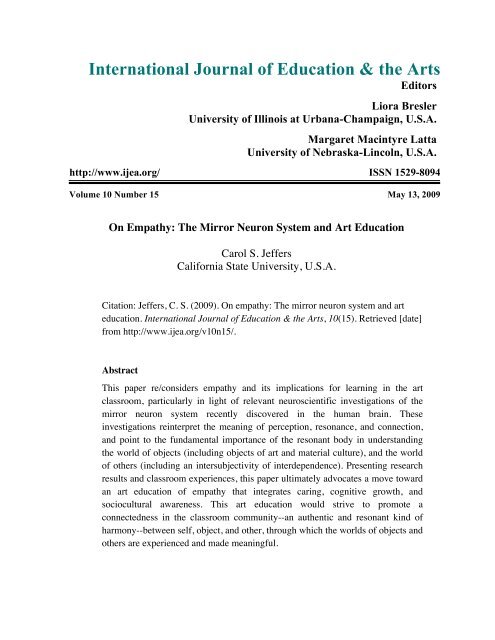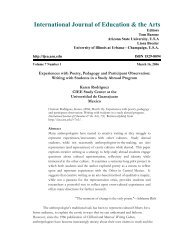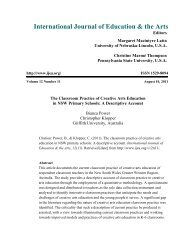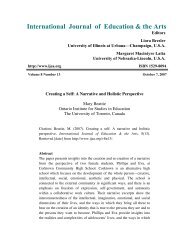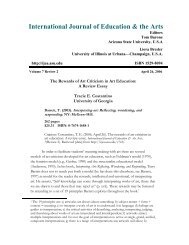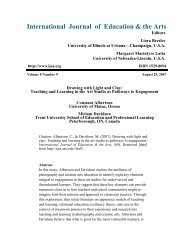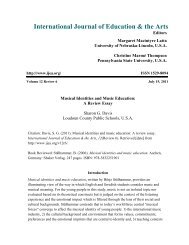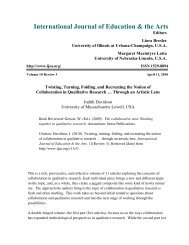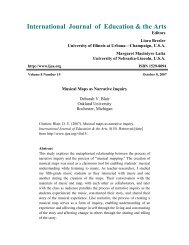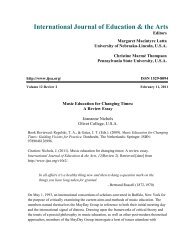On Empathy: The Mirror Neuron System and Art Education
On Empathy: The Mirror Neuron System and Art Education
On Empathy: The Mirror Neuron System and Art Education
Create successful ePaper yourself
Turn your PDF publications into a flip-book with our unique Google optimized e-Paper software.
International Journal of <strong>Education</strong> & the <strong>Art</strong>s<br />
Editors<br />
Liora Bresler<br />
University of Illinois at Urbana-Champaign, U.S.A.<br />
Margaret Macintyre Latta<br />
University of Nebraska-Lincoln, U.S.A.<br />
http://www.ijea.org/ ISSN 1529-8094<br />
Volume 10 Number 15 May 13, 2009<br />
<strong>On</strong> <strong>Empathy</strong>: <strong>The</strong> <strong>Mirror</strong> <strong>Neuron</strong> <strong>System</strong> <strong>and</strong> <strong>Art</strong> <strong>Education</strong><br />
Carol S. Jeffers<br />
California State University, U.S.A.<br />
Citation: Jeffers, C. S. (2009). <strong>On</strong> empathy: <strong>The</strong> mirror neuron system <strong>and</strong> art<br />
education. International Journal of <strong>Education</strong> & the <strong>Art</strong>s, 10(15). Retrieved [date]<br />
from http://www.ijea.org/v10n15/.<br />
Abstract<br />
This paper re/considers empathy <strong>and</strong> its implications for learning in the art<br />
classroom, particularly in light of relevant neuroscientific investigations of the<br />
mirror neuron system recently discovered in the human brain. <strong>The</strong>se<br />
investigations reinterpret the meaning of perception, resonance, <strong>and</strong> connection,<br />
<strong>and</strong> point to the fundamental importance of the resonant body in underst<strong>and</strong>ing<br />
the world of objects (including objects of art <strong>and</strong> material culture), <strong>and</strong> the world<br />
of others (including an intersubjectivity of interdependence). Presenting research<br />
results <strong>and</strong> classroom experiences, this paper ultimately advocates a move toward<br />
an art education of empathy that integrates caring, cognitive growth, <strong>and</strong><br />
sociocultural awareness. This art education would strive to promote a<br />
connectedness in the classroom community--an authentic <strong>and</strong> resonant kind of<br />
harmony--between self, object, <strong>and</strong> other, through which the worlds of objects <strong>and</strong><br />
others are experienced <strong>and</strong> made meaningful.
IJEA Vol. 10 No. 15 - http://www.ijea.org/v10n15/ 2<br />
Introduction<br />
<strong>Empathy</strong>, at root, allows the self to identify with the other <strong>and</strong> individuals to connect with<br />
groups. Facilitating holistic learning in the classroom <strong>and</strong> beyond, empathy is a vital resource<br />
that offers the promise of intersubjective underst<strong>and</strong>ing so essential to the survival of the<br />
human community. Throughout the 20th Century, all manner of psychologists, philosophers,<br />
<strong>and</strong> educators were called to study the implications of empathy’s promise, <strong>and</strong> hopefully,<br />
many will carry on this mission in the 21 st Century.<br />
Currently, neuroscientists around the world share an acute interest in empathy, kindled by the<br />
recent <strong>and</strong> still stunning discovery of mirror neurons in the human brain (Rizzolatti &<br />
Craighero, 2004). With this discovery, the neurological basis of empathy has been laid bare<br />
(Carr, Iacoboni, Dubeau, Mazziotta, & Lenzi, 2003). Subsequent investigations of this “very<br />
strange class of neurons” (Gallese, 2006) have yielded new insights, prompting some in the<br />
neuroscientific community to characterize empathy as a “biological drive” (Iacoboni, 2007) to<br />
“underst<strong>and</strong> the world of objects, [including objects of art <strong>and</strong> material culture], as well as the<br />
world of others” (Gallese, 2006; emphasis added). Aided by state-of-the-art brain imaging<br />
technologies, these investigations are lending substantial, even foundational support to the<br />
earlier insights offered by scholars in fields such as philosophy <strong>and</strong> education (Gallese, 2006;<br />
Iacoboni, 2008).<br />
In light of these developments, empathy requires systematic reexamination, particularly on the<br />
part of art educators concerned with global imagery <strong>and</strong> its power to influence personal<br />
identity <strong>and</strong> cultural awareness. New inquiries may reveal, among other things, the character<br />
of empathy at the nexus of nature <strong>and</strong> culture, where the bedrock importance of the body is<br />
affirmed. For now, this paper re/considers empathy, beginning with a brief history of the term,<br />
<strong>and</strong> argues for a broadened underst<strong>and</strong>ing of its neurological underpinnings <strong>and</strong> their<br />
implications for art education. It also attempts to envision an art education of empathy that<br />
would embrace new underst<strong>and</strong>ings of perception, resonance, <strong>and</strong> connection, <strong>and</strong> encompass<br />
cognition <strong>and</strong> emotion in the biocultural worlds of objects <strong>and</strong> others. Each world is described<br />
below in sections presenting relevant neuroscientific research <strong>and</strong> issues related<br />
fundamentally to learning in the art classroom.<br />
Bases of <strong>Empathy</strong><br />
As it turns out, the English word, empathy, is derived from Einfuhlung, (“in-feeling,” or<br />
“feeling into”), a German term coined by the philosopher, Robert Vischer, in 1873. At the<br />
time, Einfuhlung was used in the lively debate concerning the polemics of idealist <strong>and</strong><br />
formalist properties of art in Vischer’s native Germany (Gallese, 2006). Though it invoked a<br />
kind of “aesthetic sympathy” or “psychological aesthetics,” Einfuhlung was intended to
Jeffers: <strong>On</strong> <strong>Empathy</strong> 3<br />
describe the projection of human feeling into art objects (Freedberg & Gallese, 2007). As<br />
Vischer himself described this phenomenon: “I transpose myself into the inner being of an<br />
object <strong>and</strong> explore its formal character from within, as it were” (as cited in Gallese, 2006).<br />
From within the strokes, gestures, <strong>and</strong> depicted content of the work, Vischer was to<br />
experience a physical intimacy, a kind of carnal connection to the object of art.<br />
For some twenty-five years, Einfuhlung remained the province of philosophy, until <strong>The</strong>odor<br />
Lipps exp<strong>and</strong>ed the term’s meaning to include visual illusions, <strong>and</strong> then, removed it from the<br />
aesthetic debate altogether by repositioning it within the domain of psychology. Though<br />
Lipps, the philosopher said to have been most admired by Freud, began with an interest in the<br />
relationship between a work of art <strong>and</strong> its viewer, he later focused on relationships between<br />
human beings <strong>and</strong> the psychological processes he believed could explain how one person<br />
might discover the self of another (Jahoda, 2005). With this interest in intersubjectivity, Lipps<br />
extended Vischer’s notion of transposition, reasoning that if human feeling could be projected<br />
into objects, then it could also be projected into human beings. More specifically, he focused<br />
on “inner imitation,” the process by which one individual found his/her own emotions stirring<br />
when observing the emotional gestures of another (Jahoda, 2005). In his 1903 treatise on inner<br />
imitation, Lipps offered evidence drawn from his experience of acrobatic performances on the<br />
high wire. When witnessing these adrenalin-pumping performances, Lipps claimed that “we<br />
feel ourselves inside the acrobat” (as cited in Iacoboni, 2008, p. 109).<br />
Lipps used inner imitation, which in his view was essentially similar to the long-established<br />
notion of “sympathy,” (“feeling with”), to redefine Einfuhlung. However, Edward Titchener,<br />
a professor of psychology at Cornell University who established its psychology laboratory <strong>and</strong><br />
a theory of mental structures, did not share this view. In the early 1900s, he translated<br />
Einfuhlung into English, creating the word “empathy” that would distinguish it from<br />
“sympathy” forever more (Jahoda, 2005). With the discovery of mirror neurons less than a<br />
century later, however, this battle over terms seems irrelevant, if not quaint. Regardless of the<br />
labels applied, mirror neurons can be understood as the basic units of Titchener’s empathy—<br />
its mental structures, as it were. At the same time, the remarkable mirroring mechanism of<br />
these cells presents an empirical explanation of Lipps’ experience of inner imitation.<br />
Connected historically, as well as biologically to empathy, then, mirror neurons deserve closer<br />
attention at this point in the discussion. <strong>The</strong>y are typically described for lay audiences in terms<br />
of their functional properties, for example by the neuroscientist, Marco Iacoboni (2008), as<br />
those cells in the human brain that “seem specialized in underst<strong>and</strong>ing our existential<br />
condition <strong>and</strong> our involvement with others” (p. 267). Located in area F5 (premotor cortex),<br />
these cells are specialized specifically in “coding” for h<strong>and</strong> actions, including grasping <strong>and</strong><br />
gesturing (Iacoboni, 2008), <strong>and</strong> are activated both when such actions are executed by one
IJEA Vol. 10 No. 15 - http://www.ijea.org/v10n15/ 4<br />
human being <strong>and</strong> observed by another. As Iacoboni (2007) explains: “when I see you grasping<br />
something, the same cells in my brain are activated, so it’s almost like I’m in your mind”<br />
(emphasis added).<br />
Also found in area F5 <strong>and</strong> concerned with motor behaviors of the h<strong>and</strong> are the canonical<br />
neurons <strong>and</strong> possibly, the “super mirror neurons” (Iacoboni, 2008). Unlike their mirroring<br />
neighbors, canonical neurons fire at the very sight of a graspable object, invoking in the brain<br />
the “motor plans” necessary to grasp that object (Iacoboni, 2008). Super mirror neurons,<br />
according to Iacoboni’s (2008) hypothesis, suggest a “functional neuronal layer ‘on top’ of the<br />
classical mirror neurons” that controls their activity, increasing or decreasing their firing rates<br />
(p. 203). Important in action observation, ostensibly, super mirror neurons play a role in<br />
differentiating self <strong>and</strong> other, for example, by preventing one’s own h<strong>and</strong> from grasping while<br />
observing the grasping action of another (Iacoboni, 2008). A functional system, the mirror,<br />
canonical, <strong>and</strong> hypothetical super mirror neurons challenge traditional notions about<br />
perception. As the neuroscientist, Vittorio Gallese (2006) points out: “we don’t just perceive<br />
with the visual system, we perceive also with the motor system.” Indeed, action <strong>and</strong><br />
perception are not separate, but inextricably linked in area F5 of the brain (Iacoboni, 2008).<br />
<strong>The</strong> pattern of activity in the mirror neuron system allows human beings to experience their<br />
own actions <strong>and</strong> those of others at an abstract level of representation; that is, through an<br />
“embodied simulation” (Freedberg & Gallese, 2007; Gallese, 2006). Such a motor simulation,<br />
according to Gallese (2006), “allows our body to resonate along with the bodies of others.”<br />
Laying the neurological foundation for empathy, these simulations are critically important in<br />
enabling people to share their experiences <strong>and</strong> underst<strong>and</strong> the h<strong>and</strong>- <strong>and</strong> object-related actions<br />
that characterize the world of objects. Including objects of art <strong>and</strong> material culture, as well as<br />
the h<strong>and</strong> tools used in studio classrooms, this world is resonant in art education.<br />
<strong>The</strong> World of Objects<br />
<strong>The</strong> question of how people underst<strong>and</strong> objects—the things of material life—has been pursued<br />
by philosophers <strong>and</strong> neuroscientists alike. Vischer, <strong>and</strong> later, Merleau-Ponty, for example,<br />
understood objects by experiencing them intimately. For Merleau-Ponty (1964), though,<br />
connections to things were forged in <strong>and</strong> made resonant by the body. In his words: “Things<br />
have an internal equivalent in me. <strong>The</strong>y arouse in me a carnal formula of their presence” (p.<br />
164). Neuroscientific evidence now supports the existentialist notion that things are<br />
understood corporally. Objects induce embodied simulations that represent the acts of<br />
selecting, holding, or manipulating them long associated with human experience <strong>and</strong> cultural<br />
expression. <strong>The</strong> grasping actions <strong>and</strong> “motor plans” necessary to apprehend such objects are,<br />
according to Iacoboni (2008), “inherently linked” to our very underst<strong>and</strong>ing of them (p. 14).
Jeffers: <strong>On</strong> <strong>Empathy</strong> 5<br />
Through embodied simulation, moreover, this existential underst<strong>and</strong>ing is shared person to<br />
person.<br />
As it turns out, neuroscientific research indicates that mirror neurons fire not only when<br />
executing <strong>and</strong> observing object-related h<strong>and</strong> actions, but also when anticipating that such<br />
actions will occur (Grafton, Fadiga, Arbib, & Rizzolatti, 1997; Johnson-Frey, Maloof,<br />
Newman-Noulund, Farrer, Inati, & Grafton, 2003). Reporting on these experiments, Gallese<br />
(2006) notes that mirror neurons fire<br />
when we observe a h<strong>and</strong> disappearing behind an occluding screen where we know<br />
an object, a bottle is hidden, <strong>and</strong> we imagine the h<strong>and</strong> doing something with the<br />
object. Even when we see a static h<strong>and</strong> positioned in a goal-related fashion, or an<br />
image of the h<strong>and</strong> about to grasp the bottle, this activates these neurons.<br />
More surprising, perhaps, are findings demonstrating that simply listening to a sentence that<br />
describes an action also induces a motor simulation of that action (Glenberg & Kaschak,<br />
2002; Zwaan & Taylor, 2006).<br />
Research involving the canonical neurons indicates that neither the h<strong>and</strong>, nor its image is<br />
required to induce a motor simulation in the observer; images of a hammer <strong>and</strong> screwdriver<br />
are sufficient (Grafton et al., 1997). Participants recognized the “representational content” <strong>and</strong><br />
“intentional interactions” of such tools, <strong>and</strong> thus, mentally reconstructed the ways in which<br />
they are to be grasped, manipulated, <strong>and</strong> used (Freedberg & Gallese, 2007, p. 4). Though the<br />
paintbrush, palette knife, <strong>and</strong> computer mouse were not included in this study, it is reasonable<br />
to assume that such tools would also activate the canonical neurons, inducing a motor<br />
simulation, particularly within the artistic community, as they clearly specify “intentional<br />
interactions,” as well as imagined artistic possibilities. <strong>The</strong>se tools <strong>and</strong> other graspable objects<br />
are not innocuous, but rather, act as potent signifiers that also have biological, cultural, <strong>and</strong><br />
educational implications.<br />
Canonical neurons are also implicated in research indicating that the observation of a stroke or<br />
a letter, “static graphic artifacts”, evokes a motor simulation of the gesture that is required to<br />
produce it (Knoblich, Seigerschmidt, Flach, & Prinz, 2002; Longcamp, Tanskanen, & Hari,<br />
2006). Such evidence, according to Freedberg <strong>and</strong> Gallese (2007), demonstrates that “the<br />
brain can reconstruct actions by merely observing the static graphic outcome of an agent’s<br />
past action” (p. 6). This reconstructive process is “an embodied simulation mechanism that<br />
relies on the activation of the same motor centers required to produce the graphic sign”<br />
(Freedberg & Gallese, 2007, p. 6). With respect to the strokes produced by brushes or palette<br />
knives, it can be inferred that the “particular gestural traces” of the artist’s h<strong>and</strong> would also
IJEA Vol. 10 No. 15 - http://www.ijea.org/v10n15/ 6<br />
induce a motor simulation in viewers interacting with works of art (Freedberg & Gallese,<br />
2007, p. 6).<br />
Indeed, Freedberg <strong>and</strong> Gallese (2007) predict that future studies using art works as “stimuli”<br />
will confirm activation of the mirroring mechanism in the motor region (p. 6). Jackson<br />
Pollock’s action paintings are obvious c<strong>and</strong>idates, likely to induce motor simulations of the<br />
abstract expressionist’s “gestural traces.” Less obvious, perhaps, but no less likely to evoke a<br />
motor response is the still life. As Freedberg <strong>and</strong> Gallese (2007) point out, “a still life can be<br />
‘animated’ by the embodied simulation it evokes in the observer’s brain” (p. 5). Simply put, a<br />
“still life is not so still…[it] is really a moving life” (Gallese, 2006). Whereas objects of art<br />
may or may not be experienced as emotionally “moving,” they always evoke “moving”<br />
experiences, neurologically speaking. Moving art in any sense is experienced in <strong>and</strong> through<br />
the resonant body, constituting the kind of aesthetic-empathic experience that, interestingly<br />
enough, Vischer first described more than a century ago.<br />
<strong>The</strong> World of Others<br />
Navigating the world of others requires empathic underst<strong>and</strong>ing of the self, as well as of the<br />
other, <strong>and</strong> an ongoing negotiation of the intersubjective relationship between the two. In<br />
Western culture, the self-other relationship has been variously characterized, as myriads of<br />
philosophers, psychologists, <strong>and</strong> cognitive neuroscientists were challenged to resolve the<br />
perennial problem of intersubjectivity: If a human being (self) has direct access only to the<br />
private entity of his/her own mind, then how is it possible to access the mind of another? How<br />
can the world be shared meaningfully between minds? What is the possibility of empathy?<br />
In some resolutions, intersubjectivity is conceptualized as a binary relationship, a Platonist or<br />
Cartesian self-other duality that, according to the psychologist, Carol Gilligan (1982/93),<br />
results in a “conflict” between responsibilities to the self <strong>and</strong> responsibilities to the other. In<br />
another resolution, self <strong>and</strong> other are envisioned as two sides of the same coin, describing an<br />
interdependent relationship between them (Iacoboni, 2008). Dualistic <strong>and</strong> interdependent<br />
proposals are consequential, as each defines the self <strong>and</strong> other, <strong>and</strong> the nature of their<br />
encounters. Gilligan (1982/93) posits, for example, that when responsibilities to others are<br />
accepted, the self is defined in context of the activities that bring it into connection with<br />
others. This self measures the worth of these activities against an “ethic of care” (pp. 34-35).<br />
Exp<strong>and</strong>ing on the ethical <strong>and</strong> moral dimensions of caring, the educational researcher <strong>and</strong><br />
philosopher, Nel Noddings (1984) describes this self as one who is prepared to receive the<br />
other. This kind of self, according to Gilligan (1982/93), tends to locate its being in relation to<br />
the world. When, on the other h<strong>and</strong>, responsibilities to the self are placed above those to<br />
others, this self is defined in separation from others. <strong>The</strong> isolated self assesses its worth
Jeffers: <strong>On</strong> <strong>Empathy</strong> 7<br />
against an “abstract ideal of perfection” involving issues of “character <strong>and</strong> status” <strong>and</strong> tends to<br />
position the world in relation to the self. (p. 35).<br />
In an interdependent intersubjectivity, self <strong>and</strong> other are defined existentially, in terms of their<br />
concrete encounters, or in Merleau-Ponty’s (1964) experience, their embodied interactions.<br />
This lived encounter both shapes <strong>and</strong> situates self-other in a “we-centered” shared space<br />
(Gallese, 2003, p. 174), where their interactions become the “shared existential meaning that<br />
connects them deeply “ (Iacoboni, 2008, p. 265). Both Iacoboni <strong>and</strong> Gallese find solid support<br />
for an interdependent intersubjectivity in the research on mirror neurons. As Iacoboni (2008)<br />
sees it, “mirror neurons put the self <strong>and</strong> other back together” (p. 155), creating a “sense of us,”<br />
<strong>and</strong> “some kind of magical connection between people” (Iacoboni, 2007). Gallese (2003)<br />
proposes in his “shared manifold hypothesis” that mirror neurons “instantiate a supramodal<br />
intentional shared space” allowing human beings “to appreciate, experience, <strong>and</strong> implicitly<br />
<strong>and</strong> prereflexively underst<strong>and</strong> the emotions <strong>and</strong> sensations we take others to experience” (p.<br />
177).<br />
<strong>Mirror</strong> neurons are instrumental in activating intersubjectivity, beginning with the most<br />
fundamental self-other relationship that involves the “early interactive capacities of babies<br />
displayed <strong>and</strong> developed in mother-baby <strong>and</strong> father-baby interactions” (Iacoboni, 2008, p.<br />
155). Such interactions, moreover, are likely to develop the super mirror neurons, which,<br />
according to Iacoboni’s (2008) hypothesis, represent a “wonderfully simple neural distinction<br />
between self <strong>and</strong> other” (p. 203). Throughout life, it is the pattern of activity among the mirror<br />
neurons <strong>and</strong> perhaps, the super mirror neurons that allows human beings—the species wired<br />
for empathy—to underst<strong>and</strong> the existential meaning of engagement in the world of<br />
experience. Specialized for involvement with others, these cells “show that we are not alone,<br />
but are biologically wired <strong>and</strong> evolutionarily designed to be deeply interconnected with one<br />
another” (Iacoboni, 2008, p. 267).<br />
To investigate empathy as a “biological drive” in the world of others—to study its role in an<br />
interdependent intersubjectivity--is to underst<strong>and</strong> how the human brain simulates the body<br />
states, particularly those associated with emotions <strong>and</strong> sensations. As the cognitive<br />
neuroscientist, Antonio Damasio (2006) explains:<br />
If you have the possibility of simulating your own body states, you also have the<br />
possibility of simulating the body states of others; you can go from the body of<br />
the self to the body of another <strong>and</strong> through the body, into the mind of another.<br />
Through embodied simulations, then, intersubjectivity is made resonant <strong>and</strong> comprehensible,<br />
<strong>and</strong> the “actions, emotions, <strong>and</strong> sensations experienced by others become implicitly
IJEA Vol. 10 No. 15 - http://www.ijea.org/v10n15/ 8<br />
meaningful to us because we can share them with others” (Gallese, 2003, p. 176). <strong>Empathy</strong> is<br />
possible, playing a crucial role in social life <strong>and</strong> in allowing people “to share emotion,<br />
experiences, needs, <strong>and</strong> goals” (Iacoboni, 2008, p. 109). At the most fundamental level,<br />
empathy allows us to underst<strong>and</strong> facial expressions, gestures, intentions, feelings, language,<br />
<strong>and</strong> metaphor.<br />
Evidence of basic empathic underst<strong>and</strong>ings comes from those cognitive studies designed to<br />
investigate how facial expressions <strong>and</strong> the feelings they signify evoke responses in the<br />
observer. To study the feeling of disgust, for example, Heining, et al. (2003) scanned the<br />
brains of participants who observed the faces of actors portraying looks of disgust, happiness,<br />
<strong>and</strong> neutrality. <strong>The</strong>se participants were also scanned while inhaling a disgusting odor.<br />
Comparing the two scans, researchers found an activation of a region within the anterior<br />
insula, both when participants directly experienced the disgusting smell <strong>and</strong> observed the look<br />
of disgust. <strong>The</strong> look, as Gallese (2006) concludes, induces a “visceral motor somatosensoryrelated<br />
embodied simulation” of the feeling of disgust.<br />
In other research, Sonnby-Borgstrom (2003) <strong>and</strong> Dinberg (1982) found that participants’<br />
facial muscles were activated in keeping with the emotions they observed on the faces of<br />
others. For example, the activity of cheek muscles used for smiling increased among<br />
participants when observing happy faces, as did the activity of brow muscles used for<br />
frowning when observing angry faces (Dinberg, 1982). <strong>The</strong>se results suggest a kind of “motor<br />
mimicry” that, according to Iacoboni (2008), aids perception <strong>and</strong> non-verbal communication<br />
(pp. 110-11). In addition, the Sonnby-Borgstrom (2003) study further demonstrated that the<br />
degree to which facial muscles were activated correlated positively with the participants’<br />
scores on an empathy inventory questionnaire; that is, the higher the scores, the more muscle<br />
activation, <strong>and</strong> ostensibly, the greater the capacity for empathy. <strong>The</strong>se <strong>and</strong> other results<br />
prompt Gallese (2003) to propose that “sensations <strong>and</strong> emotions displayed by others can also<br />
be ‘empathized,’ <strong>and</strong> therefore implicitly understood, through a mirror matching mechanism”<br />
(p. 176).<br />
It seems likely that similar results would be obtained if participants were to observe artistic<br />
renderings of the human face. Though unconfirmed by empirical measures as yet, there is<br />
compelling, if anecdotal evidence suggesting that the faces of museum visitors resonate along<br />
with the facial expressions of exhibited portraits. Indeed, these artforms, or “artifacts,” as<br />
Danesi (1993) describes them, are a “means for evoking fundamental feelings <strong>and</strong> sensations”<br />
(p. 77). This appeared to be the case when visitors to the Getty Museum were caught up in an<br />
empathic-aesthetic experience of Bill Viola’s video art, Six Heads (2000), a key piece in his<br />
larger work, <strong>The</strong> Passions (2000-02). <strong>On</strong> a single screen, visitors found an actor’s face <strong>and</strong>
Jeffers: <strong>On</strong> <strong>Empathy</strong> 9<br />
were captivated by its gradual, almost imperceptible changes in expression, from joy to<br />
sorrow, to anger, fear, awe, <strong>and</strong> dream-state.<br />
Such facial mimicry, with its perceptual, communicative, <strong>and</strong> empathic features, invokes an<br />
existentialist intersubjectivity summarized by Merleau-Ponty (1964) in a single line: “I live in<br />
the facial expression of the other, as I feel him living in mine” (p. 146). Inspiring an<br />
“existential neuroscience” (Iacoboni, 2008), Merleau-Ponty’s lived experience <strong>and</strong> the<br />
Husserlian notion, “back to the things themselves,” fit well with the themes explored in mirror<br />
neurons research. Interestingly, elements of existential phenomenology <strong>and</strong> existential<br />
neuroscience also fit with Lipps’ (1903) earlier notion of “inner imitation.”<br />
Indeed, results of recent research exploring more complex human interactions appear to<br />
further outline the contributions of the mirror neuron system to an existential, if imitative<br />
intersubjectivity. In a study of the relationship between training, skill level, <strong>and</strong> resonance, for<br />
example, researchers found that the mirror neurons of professional dancers trained in classical<br />
ballet became more excited when observing other dancers performing ballet than when<br />
observing dancers performing Capoeira, a Brazilian martial arts dance (Calvo-Merino, et al.,<br />
2005). <strong>The</strong>se results suggest that bodies with particular skills <strong>and</strong> training resonate along with<br />
other bodies similarly skilled <strong>and</strong> trained. Familiarity with the skills <strong>and</strong> techniques of a<br />
particular artform appears, at first glance, to be implicated in the activation of the mirroring<br />
mechanism.<br />
However, a closer look reveals that familiarity, as the explanatory factor, has been called into<br />
question by a more recent study investigating culturally-specific h<strong>and</strong> gestures <strong>and</strong> the<br />
mirroring mechanism. Researchers found, as expected, that the mirroring cells of American<br />
participants became very excited when observing an American actor performing familiar<br />
gestures, such as the “thumbs-up” sign, typically used <strong>and</strong> understood in American culture<br />
(Momar-Szakacs, Wu, Robles, & Iacoboni, 2007). But as Iacoboni (2007) notes, an<br />
“interesting,” if unexpected finding was that the American participants’ cells were more<br />
excited when observing a Nicaraguan actor performing the unfamiliar gestures found in<br />
Nicaraguan culture, than when these participants observed the Nicaraguan actor performing<br />
American gestures. To explain, Iacoboni (2007) offers: “It is like they were underst<strong>and</strong>ing that<br />
there was some kind of harmony between the actor making the gesture <strong>and</strong> the gesture itself.”<br />
Underst<strong>and</strong>ing this “harmony,” which likely involves a bodily perception of <strong>and</strong> resonance<br />
with the authenticity <strong>and</strong>/or integrity of the performances, proved to be more important<br />
fundamentally than underst<strong>and</strong>ing the meaning of the gestures themselves.<br />
Had the design of the Calvo-Merino, et al. (2005) study of skilled dancers followed that of the<br />
Momar-Szakacs, et al. (2007) study of culturally-specific h<strong>and</strong> gestures, perhaps the results
IJEA Vol. 10 No. 15 - http://www.ijea.org/v10n15/ 10<br />
would suggest that mirror neurons of classically-trained ballet dancers were more likely to<br />
resonate when observing Brazilian dancers perform the unfamiliar Capoeira style than when<br />
observing the Brazilian dancers perform classical ballet. Indeed, it seems likely that the ballet<br />
dancers would perceive <strong>and</strong> resonate with an authenticity, or in Iacoboni’s (2007) words,<br />
“underst<strong>and</strong> a kind of harmony” between the Brazilian dancers <strong>and</strong> their native Capoeira.<br />
Similarly designed studies of the skills <strong>and</strong> activities performed in the studio classroom might<br />
yield similar results. For instance, it seems likely that the mirroring cells of students skilled in<br />
painting, say, would be more resonant when observing a painter demonstrating painting<br />
techniques than when observing a ceramic artist demonstrating wheel techniques. But it also<br />
seems likely that these students’ cells would be more activated when watching the ceramicist<br />
on the wheel than when watching this clay artist at the familiar easel. Painting students would<br />
likely underst<strong>and</strong> a resonant harmony <strong>and</strong> authenticity between the painter <strong>and</strong> the painting<br />
techniques <strong>and</strong> between the ceramic artist <strong>and</strong> the wheel techniques. Although not yet<br />
confirmed by scientific means, this kind of perceived <strong>and</strong> resonant authenticity—Iacoboni’s<br />
“harmony”--is recognizable, particularly among those in the arts community, <strong>and</strong> would be<br />
important in an empathic art education.<br />
Toward an <strong>Art</strong> <strong>Education</strong> of <strong>Empathy</strong><br />
<strong>Empathy</strong> can surely be found in art classrooms around the world, but too often, it is merely a<br />
happenstance, the resulting by-product or incidental outcome of the learning process. Any<br />
movement toward an art education of empathy must begin with a commitment to empathic<br />
learning, stated unambiguously as a goal of instruction. In this art education, empathy <strong>and</strong><br />
Noddings’ notion of caring would be conceived of as one sturdy leg in the tripod that, along<br />
with cognitive growth <strong>and</strong> sociocultural awareness, holds up a humanistic education preparing<br />
students for active membership in the pluralistic communities of the 21 st Century. Teachers<br />
would value as empathic <strong>and</strong> educative those connections that develop, say, between the<br />
kindergarten child <strong>and</strong> the bright, rapturous colors of his first easel painting, or between a high<br />
school student <strong>and</strong> her classmates with whom she shares the Cezanne still life that so inspires<br />
her. Understood in the context of the workings of the mirror neuron system, such connections<br />
would be appreciated not only for their resonance <strong>and</strong> authenticity, but also, for their potency<br />
in engendering meaning <strong>and</strong> integrating the dimensions of the self-in-relation-to-other.<br />
Ultimately, they would be consciously promoted for the educational benefits bestowed upon<br />
the classroom community <strong>and</strong> beyond.<br />
Encompassing the worlds of objects <strong>and</strong> others, this art education digs into neuroscientific<br />
research for what is revealed about the strength of the connections between empathic<br />
underst<strong>and</strong>ing, emotional intelligence, <strong>and</strong> cognitive growth that are made in <strong>and</strong> through the<br />
resonant body, particularly as this body resonates along with the bodies of other resonant
Jeffers: <strong>On</strong> <strong>Empathy</strong> 11<br />
beings. New <strong>and</strong> provocative revelations about the close, if surprising connections between<br />
action <strong>and</strong> perception are also seen as important, prompting a reform of theoretical views<br />
narrowly focused on the optics of visual perception to include a broadened underst<strong>and</strong>ing of<br />
perception as a resonant, even “moving” carnal experience. An art education of empathy<br />
searches out studies of the mirror neuron system that can explain how students connect to <strong>and</strong><br />
are connected by their interactions with objects of art, the artists producing them, <strong>and</strong> the<br />
classmates with whom they share a “we-centered” space. Invigorated by an existential<br />
neuroscience <strong>and</strong> an existential phenomenology, this art education embraces the “implicitly<br />
<strong>and</strong> prereflexively understood connections between people,” <strong>and</strong> dedicates itself to making<br />
such connections explicit <strong>and</strong> consciously understood.<br />
To be adopted are post-Cartesian or postmodern views that have long since witnessed the<br />
collapse of separate cognitive <strong>and</strong> affective domains, <strong>and</strong> of the mind-body, perceptionconception,<br />
<strong>and</strong> self-other dualisms. <strong>The</strong> art education to emerge would envision an<br />
interdependence among the once dualistic relationships, focusing particularly on an<br />
interdependent intersubjectivity around which its philosophy is oriented <strong>and</strong> in which its<br />
classroom practices are grounded. <strong>The</strong> lived encounters of self-other <strong>and</strong> self-object, as<br />
characterized by their resonance <strong>and</strong> authenticity, would shape the curriculum <strong>and</strong> define the<br />
classroom community. It is in such a community that Noddings’ (1984) vision of schools [or<br />
art classrooms] organized for caring might take hold. <strong>The</strong> caring school, as Noddings (1984)<br />
sees it, involves teachers <strong>and</strong> students in relationships with one another, rather than in<br />
traditional roles to be assumed <strong>and</strong> played out. In relationship, moreover, the teacher receives<br />
the student, <strong>and</strong> is present to the student, who is always considered to be more important than<br />
the subject matter at h<strong>and</strong>.<br />
An art education woven of caring relationships imagines something beyond the Cartesian selfother<br />
duality, recognizing at last that the self defined in isolation, avoiding its responsibilities<br />
to the other, has had particularly long-tailed consequences, which according to the artist <strong>and</strong><br />
critic, Suzi Gablik (1995), reach deep into an art world wrestling with modernist <strong>and</strong><br />
postmodernist approaches. “Embedded within modernism,” warns Gablik (1995), is a “subtle<br />
<strong>and</strong> far-reaching message concerning the loneliness <strong>and</strong> isolation of the self” (p. 17), <strong>and</strong> a<br />
“model of the lone genius struggling against society” (pp. 16-17). Gablik’s concern<br />
effectively conjure up Gilligan’s (1982/93) vision of the individual denying his/her<br />
responsibilities to others <strong>and</strong> positioning the world in relation to this isolated self. For Gablik<br />
(1995), however, there are additional consequences. As she sees it, the model of the lone<br />
genius that is the “philosophical basis for Western culture” has also “deprived art of its<br />
astonishing potential to build community through empathic social interaction” (pp. 16-17,<br />
emphasis added). A different, more empathic model would value art, not as a “visual language<br />
of form,” but as “something more interactive <strong>and</strong> dialectical in nature,” involving
IJEA Vol. 10 No. 15 - http://www.ijea.org/v10n15/ 12<br />
“participatory <strong>and</strong> dialogical practices” that include in the process an interdependence of self<br />
<strong>and</strong> others (Gablik, 1995, pp. 16-17).<br />
Empathic social interaction underpins Gablik’s (1995) advocacy of a “connective aesthetics,”<br />
which is “based vigorously in impassioned engagement that would restore art’s connectedness<br />
with the world after a century of vision-oriented, purist ideals” (p. 17). This “connective<br />
aesthetics,” as informed by dialogical practices, succeeds in reuniting aesthetics <strong>and</strong> empathy<br />
[Einfuhlung], but in ways unlike Lipps’ proposal of inner imitation or Vischer’s experience of<br />
transposition. Whereas the philosophers focused on the individual, Gablik envisions the<br />
communal <strong>and</strong> a kind of existentialist “sense of us” described by Iacoboni. More importantly,<br />
Gablik’s notions of connectedness are supported by the findings of existential neuroscience,<br />
<strong>and</strong> thus, offer a compelling biocultural model for an art education of empathy.<br />
<strong>The</strong> following passages offer a brief sketch of how this model was applied in an attempted<br />
move toward an art education of empathy. Preservice teachers, mostly without background in<br />
art, experienced the connectedness of the empathic-aesthetic community described below:<br />
A Resonant Connectedness in the Classroom<br />
Students in multicultural art education <strong>and</strong> elementary art methods courses reflected on class<br />
presentations one to two weeks after having been given, focusing particularly on those they<br />
had found most memorable <strong>and</strong> vivifying. Presentations featured works of art exhibited in<br />
local museums that were unfamiliar to students, but with which they felt a personal<br />
connection, nonetheless. In other presentations, students shared a cultural icon deemed to have<br />
some personal significance. Presenters explored their connections <strong>and</strong> shared contextualizing<br />
information about the selected pieces, which included, for example: a Japanese Inro box, a<br />
Nez Perce umbilical amulet, the Buddha Shakyamuni, Tiepolo’s Triumph of Virtue <strong>and</strong><br />
Nobility over Ignorance (1740-50), Cezanne’s Still Life with Apples (1893-94), Reni’s Saint<br />
Cecilia (1606), the iconic logos of Starbuck’s, the Gap, <strong>and</strong> the Los Angeles Lakers. i In their<br />
reflections, students sometimes described presenters’ honesty, facial expressions, or emotions,<br />
for example, mentioning a face that “showed a fierce, determined look,” or “passion <strong>and</strong><br />
excitement,” <strong>and</strong> eyes filled with tears.<br />
Overwhelmingly, students wrote about the connections between classmates <strong>and</strong> their chosen<br />
pieces, both in general <strong>and</strong> specific terms. Though they did not always remember a presenter’s<br />
name or have much in common with that individual, students had clear memories of these<br />
connections, their authenticity, impact, <strong>and</strong> meaning. A small composite of these reflections is<br />
offered in the following narrative:
Jeffers: <strong>On</strong> <strong>Empathy</strong> 13<br />
What I liked the most was the way the people connected with the piece they<br />
chose… What really stayed with me were the stories <strong>and</strong> the way my classmates<br />
connected with their paintings--how they connected to the art emotionally….<br />
Most [presenters] talked about the cultural significance of the piece <strong>and</strong> how,<br />
through the information they gathered, were able to relate that to something in<br />
their own lives… I really enjoyed how [the presenter] felt a strong connection<br />
between herself <strong>and</strong> the girl in the painting ... <strong>The</strong> connection she made with the<br />
sisters <strong>and</strong> her mom really related to the painting…. I personally felt <strong>and</strong><br />
understood the connection she felt with the painting… [<strong>The</strong> presenter] made me<br />
feel the same vibration… She brought the painting to life <strong>and</strong> I was able to feel<br />
along with her… She said she wanted to be a part of the art <strong>and</strong> I understood<br />
this…. <strong>The</strong> way she used the painting metaphorically really made me feel<br />
underst<strong>and</strong>ing of what she goes through with her mom… Her piece had an impact<br />
on me because of the connection she made with it... I felt a connection with her<br />
<strong>and</strong> felt bad for her situation…. I felt like crying, too, <strong>and</strong> I think this [connection]<br />
expresses more than words… His words ran deep, <strong>and</strong> that is where the true<br />
resonance of his soul lay… <strong>The</strong> piece also opened her up to receiving some<br />
healing <strong>and</strong> a connection with the community… We all learned from another’s<br />
experiences…. I will remember her story for life.<br />
In one elementary art methods class, 12 of 29 students (41.4%), mostly in their mid- to late<br />
twenties, found the connection between Karen <strong>and</strong> her piece to be especially resonant <strong>and</strong><br />
memorable. Though she was a returning student, a mature woman <strong>and</strong> single mother of three,<br />
these students found Karen’s connection to Van Gogh’s <strong>The</strong> Mulberry Tree (1889) to be as<br />
vivid as it was compelling, evoking in them a strong empathic response to her, as well as to<br />
the artist. In the painting, the students “saw what she saw”-- “a lonely tree surrounded by<br />
wind,” that looked “very alive, as well as distorted,” with “its wild, chaotic-looking branches<br />
going in all directions” -- <strong>and</strong> they understood that the “craziness” of these branches “gave a<br />
visual” to what “Karen was feeling inside.” As she described her life in chaos, her “distorted<br />
thoughts” <strong>and</strong> “scattered feelings” brought on by the recent death of one son, the incarceration<br />
of another, <strong>and</strong> the life-long struggle of her Down’s Syndrome daughter, the younger students<br />
felt what she felt. “<strong>The</strong> story stuck out to me because I felt the same when I saw the painting.”<br />
“Listening to her story, <strong>and</strong> looking at <strong>The</strong> Mulberry Tree, I saw what she felt for a brief<br />
moment.” “She felt lost <strong>and</strong> confused, <strong>and</strong> I understood this.”<br />
For these students, there was also a resonance in Van Gogh’s story. <strong>The</strong>y internalized the<br />
information Karen had shared about his stay at the psychiatric hospital overlooking Saint<br />
Remy <strong>and</strong> believed that <strong>The</strong> Mulberry Tree captured his own chaotic feelings. “<strong>On</strong>ce we knew<br />
more about the artist, the piece became even more captivating. <strong>The</strong>n I knew Van Gogh’s
IJEA Vol. 10 No. 15 - http://www.ijea.org/v10n15/ 14<br />
struggles, like hers, were caught in the painting.” Moreover, students understood that Karen,<br />
having identified herself with Van Gogh’s story, experienced a modicum of relief because she<br />
felt less alone. As she put it: “I’m not the only one who is crazy.” Like Lipps <strong>and</strong> the acrobat,<br />
Karen had felt herself inside Van Gogh’s own precarious position.<br />
In these preservice classes, it is clear that students understood a resonant harmony, or “felt the<br />
same vibration,” between the presenters <strong>and</strong> their chosen pieces. <strong>The</strong> elegant circuitry of the<br />
mirror neuron system made this resonance possible, creating “magical connections” between<br />
students as they moved from their own body states into those of the presenters <strong>and</strong> through<br />
those body states, into the mind of the presenter, <strong>and</strong> in Karen’s case, into the mind of the<br />
artist. In an application of existential neuroscience, students implicitly understood an<br />
interdependence of self <strong>and</strong> other, self <strong>and</strong> artist that animated their experiences within the<br />
shared space of their caring community. <strong>The</strong> act of presenting themselves <strong>and</strong> their pieces,<br />
which brought students into connection with one another, promoted empathy <strong>and</strong> in their<br />
words, a willingness to offer “some healing,” <strong>and</strong> a “connection with the community.”<br />
Within these connections, art was “brought to life,” animated by more than the motor<br />
simulations its gestural strokes <strong>and</strong> subject matter induced in the students. Through the visual<br />
content, the language used to describe it, <strong>and</strong> participation in dialogue about the piece, there<br />
was an empathic stirring of cells <strong>and</strong> psyche. Literally <strong>and</strong> figuratively, students experienced a<br />
classmate as “the girl in the painting,” or the wind in the chaotic branches scattering the pieces<br />
of Karen’s life. Transposing their stories <strong>and</strong> feelings into objects of art <strong>and</strong> material culture,<br />
they envisioned themselves <strong>and</strong> their classmates, Vischer-like, as “part of the art.” <strong>The</strong>se<br />
intimate experiences went a long way toward restoring “art’s connectedness with the world.”<br />
Laced with emotion <strong>and</strong> fusing lives with resonant objects, students’ stories represented the<br />
“impassioned engagement” of a “connective aesthetics.” This connectedness constituted a<br />
kind of empathic learning that was profoundly meaningful, moving students beyond<br />
intellectual or detached learning to emotional underst<strong>and</strong>ing. Explaining the importance of<br />
such learning, Danesi (1993) points out: “the juxtaposition of artifact with feeling is a<br />
powerful means of making meaning in the world <strong>and</strong> extracting meaning from it” (p. 77). An<br />
art education of empathy promotes such a means.<br />
<strong>Empathy</strong> is required if we are to share so fragile a planet; if we are to underst<strong>and</strong> the gestures<br />
<strong>and</strong> expressions of others, <strong>and</strong> the globally-accessible images <strong>and</strong> icons they produce <strong>and</strong><br />
consume. A connective force, empathy is to be prized by art education, the field poised to<br />
unleash art’s community-building potential <strong>and</strong> to enable young people to grasp the meaning,<br />
the power of connection. An art education of empathy embraces the resonance of mind <strong>and</strong><br />
body, a resonance running deep into the collective soul. This art education builds human<br />
capacities to negotiate the worlds of objects <strong>and</strong> others with care <strong>and</strong> empathic insight.
Jeffers: <strong>On</strong> <strong>Empathy</strong> 15<br />
Note<br />
1. A more detailed description of students’ connections to an Inro box, umbilical amulet, <strong>and</strong><br />
the Buddha Shakymuni is presented in the article, “<strong>Empathy</strong>, Cultural <strong>Art</strong>, <strong>and</strong> <strong>Mirror</strong><br />
<strong>Neuron</strong>s: Implications for the Classroom <strong>and</strong> Beyond,” in the Journal of Cultural Research in<br />
<strong>Art</strong> <strong>Education</strong> (2008). Students’ connections to paintings by Tiepolo, Cezanne, <strong>and</strong> Reni <strong>and</strong><br />
to the iconic logos of the Gap <strong>and</strong> the Los Angeles Lakers are more fully discussed in “Within<br />
Connections: <strong>Empathy</strong>, <strong>Mirror</strong> <strong>Neuron</strong>s, <strong>and</strong> <strong>Art</strong> <strong>Education</strong>,” published in <strong>Art</strong> <strong>Education</strong>,<br />
March, 2009.<br />
References<br />
Calvo-Merino, B., Glaser, D. E., Grezes, J., Passingham, R. E., & Haggard, P. (2005). Action<br />
observation <strong>and</strong> acquired motor skills: An fMRI study with expert dancers. Cerebral<br />
Cortex, 15, 1243-49.<br />
Carr, L., Iacoboni, M., Dubeau, M., Mazziotta, J., & Lenzi, G. (2003). Neural mechanisms of<br />
empathy in humans: A relay from neural systems for imitation to limbic areas.<br />
Proceedings of the National Academy of Sciences U.S.A., 100, 5497-5502.<br />
Damasio, A. (2006, March 24). Lecture at the Forum on <strong>Art</strong> <strong>and</strong> the New Biology of Mind.<br />
Italian Academy for Advanced Studies in America, Columbia University, New York.<br />
NY. Available as an online video at<br />
http://www.columbia.edu/cu/news/media/06/421_neuroBio<strong>Art</strong>s/antonioDamasio.ram<br />
Danesi, M. (1993). Messages <strong>and</strong> meanings: An introduction to semiotics. Toronto: Canadian<br />
Scholars’ Press Inc.<br />
Dinberg, U. (1982). Facial reactions to facial expressions. Psychophysiology, 19, 643-647.<br />
Freedberg, D. & Gallese, V. (2007). Motion, emotion, <strong>and</strong> empathy in aesthetic experience.<br />
Trends in Cognitive Sciences, doi:10.10.16/j.tics.2007.02.03<br />
Gablik, S. (1995). Conversations before the end of time. New York: Thames <strong>and</strong> Hudson.<br />
Gallese, V. (2003). <strong>The</strong> roots of empathy: <strong>The</strong> shared manifold hypothesis <strong>and</strong> the neural<br />
basis of intersubjectivity. Psychopathology, 36, 171-180.<br />
Gallese, V. (2006, March 24). Lecture at the Forum on <strong>Art</strong> <strong>and</strong> the New Biology of Mind.<br />
Italian Academy for Advanced Studies in America at Columbia University, New York,<br />
NY. Available as an online video at<br />
http://www.columbia.edu/cu/news/media/06/421_neuroBio<strong>Art</strong>s/vittorioGallese.ram<br />
Gilligan, C. (1982/93). In a different voice: Psychological theory <strong>and</strong> women’s development.<br />
Cambridge: Harvard University Press.
IJEA Vol. 10 No. 15 - http://www.ijea.org/v10n15/ 16<br />
Glenberg, A. M. & Kaschak, M. P. (2002). Grounding language in action. Psychonomic<br />
Bulletin & Review, 9, 558-565.<br />
Grafton, S.T., Fadiga, L., Arbib, M.A., & Rizzolatti, G. (1997). Premotor cortex activation<br />
during observation <strong>and</strong> naming of familiar tools. Neuroimage, 6, 231-236.<br />
Heining, M., Young, A., Ioannou, G., Andrew, C., Brammer, M., Gray, J., & Phillips, M.<br />
(2003). Disgusting smells activate human anterior insula <strong>and</strong> ventral stratum. Annals<br />
of the New York Academy of Sciences, 1000(1), 580-584.<br />
Hubard, O. (2007). Complete engagement: Embodied response in art museum education. <strong>Art</strong><br />
<strong>Education</strong>, 61(6), 46-52.<br />
Iacoboni, M. (interviewee). (2007). Interview with Larry Mantle, KPCC’s Air Talk. Retrieved<br />
July 26, 2007 from<br />
http://www.publicradio.org/tools/media/player/kpcc/news/shows/airtalk/2007/07/2007<br />
0725_airtalk2?start=00:28:28&end=00:52:31<br />
Iacoboni, M. (2008). <strong>Mirror</strong>ing people: <strong>The</strong> new science of how we connect with others. New<br />
York: Farrar, Straus <strong>and</strong> Giroux.<br />
Jahoda, G. (2005). <strong>The</strong>odor Lipps <strong>and</strong> the shift from “sympathy” to “empathy.” Journal of the<br />
History of Behavioural Sciences, 4(2), 151-163.<br />
Johnson-Frey, S.H., Maloof, F.R., Newman-Norlund, R., Farrer, C., Inati, S., & Grafton, ST.<br />
(2003). Actions or h<strong>and</strong>-object interactions? Human inferior frontal cortex <strong>and</strong> action<br />
observation. <strong>Neuron</strong>, 39, 1053-1058.<br />
Knoblich, G., Seigerschmidt, E., Flach, R., & Prinz, W. (2002). Authorship effects in the<br />
prediction of h<strong>and</strong>writing strokes: Evidence for action simulation during action<br />
perception. Quarterly Journal of Experimental Psychology, 55A, 1027-1046.<br />
Lipps, T. (1903). Einfuhlung, innere Nachahmung und Organempfindung. Archive fur die<br />
Gesamte Psychologie, 1(2). Leipzig, Germany: W. Engelmann.<br />
Longcamp, M., Tanskanen, T., & Hari, R. (2006). <strong>The</strong> imprint of action: Motor cortex<br />
involvement in visual perception of h<strong>and</strong>written letters. Neuroimage 33, 681-688.<br />
Merleau-Ponty, M. (1964). <strong>The</strong> primacy of perception (J. M. Edie, Trans.). Evanston, IL:<br />
Northwestern University Press.<br />
Momar-Szakacs, I., Wu, A., Robles, F., & Iacoboni, M. (2007). Do you see what I mean?<br />
Corticospinal excitability during observation of culture-specific gestures. Retrieved<br />
July 26, 2007 from<br />
http://www.plosone.org/article/fetch<strong>Art</strong>icle.action?articleURI=info:doi /10.1371/<br />
journal.pone.0000626
Jeffers: <strong>On</strong> <strong>Empathy</strong> 17<br />
Noddings, N. (1984). Caring: A feminine approach to ethics <strong>and</strong> moral education. Berkeley:<br />
University of California Press.<br />
Rizzolatti, G. & Criaghero, L. (2004). <strong>The</strong> mirror neuron system. Annual Review of<br />
Neuroscience, 27, 169-192.<br />
Sonnby-Borgstrom, M. (2002). Automatic mimicry reactions as related to differences in<br />
emotional empathy. Sc<strong>and</strong>inavian Journal of Psychology, 43(5), 433-443.<br />
Zwaan, R. A. & Taylor, L. (2006). Seeing, acting underst<strong>and</strong>ing: Motor resonance in language<br />
comprehension. Journal of Experimental Psychology: General, 135, 1-11.<br />
About the author<br />
Carol S. Jeffers is professor of art education at California State University at Los Angeles<br />
where she teaches a variety of courses in the general education, teacher preparation, servicelearning,<br />
<strong>and</strong> graduate programs. Her interests are in empathy, empathic listening, metaphor,<br />
dialogical processes of art, <strong>and</strong> curriculum reform. She is the author of numerous book<br />
chapter, as well as articles published in <strong>Art</strong> <strong>Education</strong>, Studies in <strong>Art</strong> <strong>Education</strong>, Journal of<br />
Aesthetic <strong>Education</strong>. Her book, Spheres of Possibility: Linking Service-Learning <strong>and</strong> the<br />
Visual <strong>Art</strong>s (NAEA, 2005), offers multiple models of service-learning in the visual arts <strong>and</strong> is<br />
often cited by scholars in the field.
International Journal of <strong>Education</strong> & the <strong>Art</strong>s<br />
Editors<br />
Liora Bresler<br />
University of Illinois at Urbana-Champaign, U.S.A.<br />
Margaret Macintyre Latta<br />
University of Nebraska-Lincoln, U.S.A.<br />
Managing Editor<br />
Alex Ruthmann<br />
University of Massachusetts Lowell, U.S.A.<br />
Associate Editors<br />
Jolyn Blank<br />
University of South Florida, U.S.A<br />
Chee Hoo Lum<br />
Nanyang Technological University, Singapore<br />
Editorial Board<br />
Peter F. Abbs<br />
Eunice Boardman<br />
Norman Denzin<br />
Kieran Egan<br />
Elliot Eisner<br />
Magne Espel<strong>and</strong><br />
Rita Irwin<br />
Gary McPherson<br />
Julian Sefton-Green<br />
Robert E. Stake<br />
Susan Stinson<br />
Graeme Sullivan<br />
Christine Thompson<br />
Elizabeth (Beau) Valence<br />
Peter Webster<br />
University of Sussex, U.K.<br />
University of Illinois at Urbana-Champaign, U.S.A.<br />
University of Illinois at Urbana-Champaign, U.S.A.<br />
Simon Fraser University, Canada<br />
Stanford University, U.S.A.<br />
Stord/Haugesund University College, Norway<br />
University of British Columbia, Canada<br />
University of Illinois at Urbana-Champaign, U.S.A.<br />
University of South Australia, Australia<br />
University of Illinois at Urbana-Champaign, U.S.A.<br />
University of North Carolina—Greensboro , U.S.A.<br />
Teachers College, Columbia University, U.S.A.<br />
Pennsylvania State University, U.S.A.<br />
Indiana University, Bloomington, U.S.A.<br />
Northwestern University, U.S.A.


